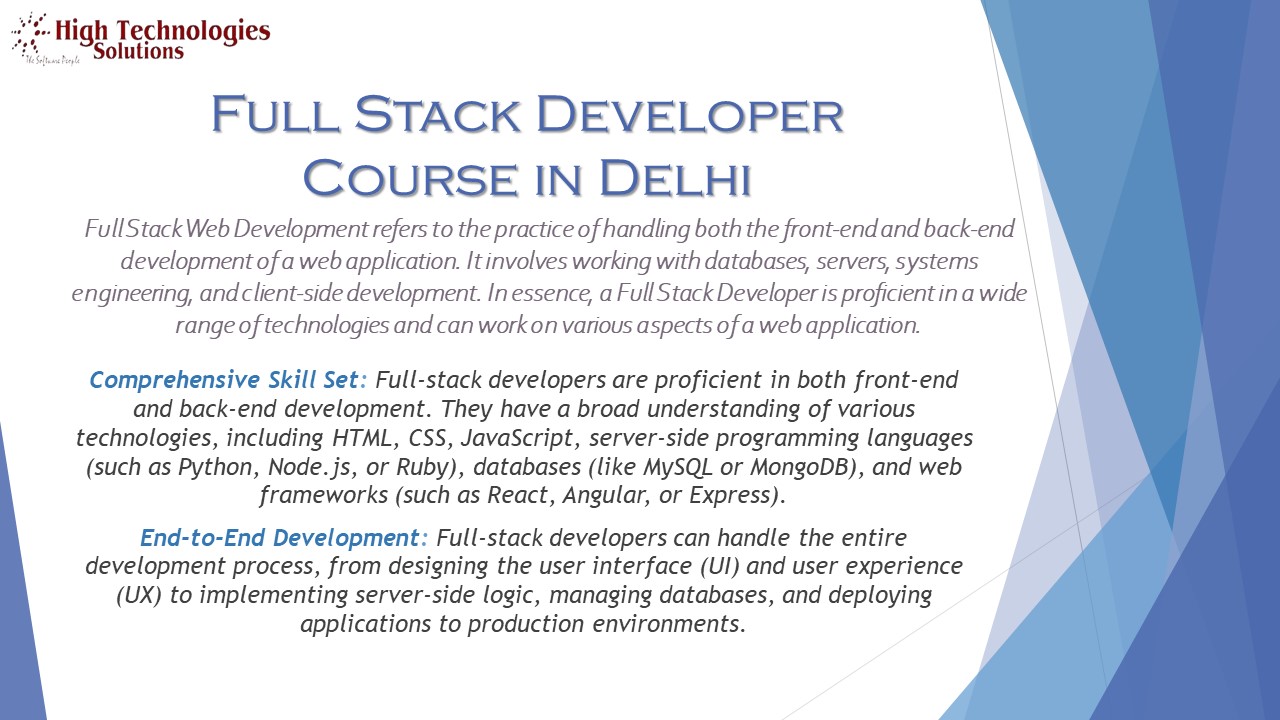Full Stack Developer Course in Delhi - PowerPoint PPT Presentation
Title:
Full Stack Developer Course in Delhi
Description:
Full Stack Web Development refers to the practice of handling both the front-end and back-end development of a web application. It involves working with databases, servers, systems engineering, and client-side development. In essence, a Full Stack Developer is proficient in a wide range of technologies and can work on various aspects of a web application. – PowerPoint PPT presentation
Number of Views:0
Title: Full Stack Developer Course in Delhi
1
Full Stack Developer Course in Delhi
- Full Stack Web Development refers to the practice
of handling both the front-end and back-end
development of a web application. It involves
working with databases, servers, systems
engineering, and client-side development. In
essence, a Full Stack Developer is proficient in
a wide range of technologies and can work on
various aspects of a web application.
- Comprehensive Skill Set Full-stack developers
are proficient in both front-end and back-end
development. They have a broad understanding of
various technologies, including HTML, CSS,
JavaScript, server-side programming languages
(such as Python, Node.js, or Ruby), databases
(like MySQL or MongoDB), and web frameworks (such
as React, Angular, or Express). - End-to-End Development Full-stack developers can
handle the entire development process, from
designing the user interface (UI) and user
experience (UX) to implementing server-side
logic, managing databases, and deploying
applications to production environments.
2
Types of Web Development
- Front-End Development Front-end development
involves creating the user interface (UI) and
user experience (UX) of websites. It focuses on
the visual aspects that users interact with
directly in their web browsers. Technologies
commonly used in front-end development include
HTML, CSS, and JavaScript, along with frameworks
and libraries like React, Angular, and Vue.js. - Back-End Development Back-end development deals
with the server-side of web applications. It
involves handling databases, server logic,
authentication, and data processing. Popular
back-end programming languages include Python
(with frameworks like Django or Flask), Node.js
(with frameworks like Express.js), Ruby (with
Ruby on Rails), and PHP (with frameworks like LA
ravel or Symphony). - Full-Stack Development Full-stack development
covers both front-end and back-end aspects of web
development. Full-stack developers have expertise
in both client-side (front-end) technologies such
as HTML, CSS, and JavaScript, as well as
server-side (back-end) technologies like
databases, server scripting, and API
integrations. They can work on all layers of a
web application, from UI design to server
deployment.
3
Web development plays a crucial role in today's
digital age for several reasons
- Online Presence
- Customer Interaction
- A well-developed website is essential for
businesses, organizations, and individuals to
establish a strong online presence. It serves as
a virtual storefront, providing information about
products, services, contact details, and more to
a global audience 24/7. - Brand Identity Web development helps in shaping
and reinforcing brand identity. Through strategic
design, content creation, and user experience
optimization, websites can convey the brand's
values, mission, and personality effectively,
leaving a lasting impression on visitors.
- Websites enable direct interaction with customers
through features like contact forms, live chat
support, feedback forms, and social media
integrations. This facilitates communication,
feedback gathering, and customer support,
enhancing overall customer experience. - Competitive Advantage In a competitive market, a
professionally developed website gives businesses
a competitive edge. A visually appealing,
functional, and user-friendly website
differentiate the brand from competitors, and
build credibility and trust. an attract and
retain customers,































